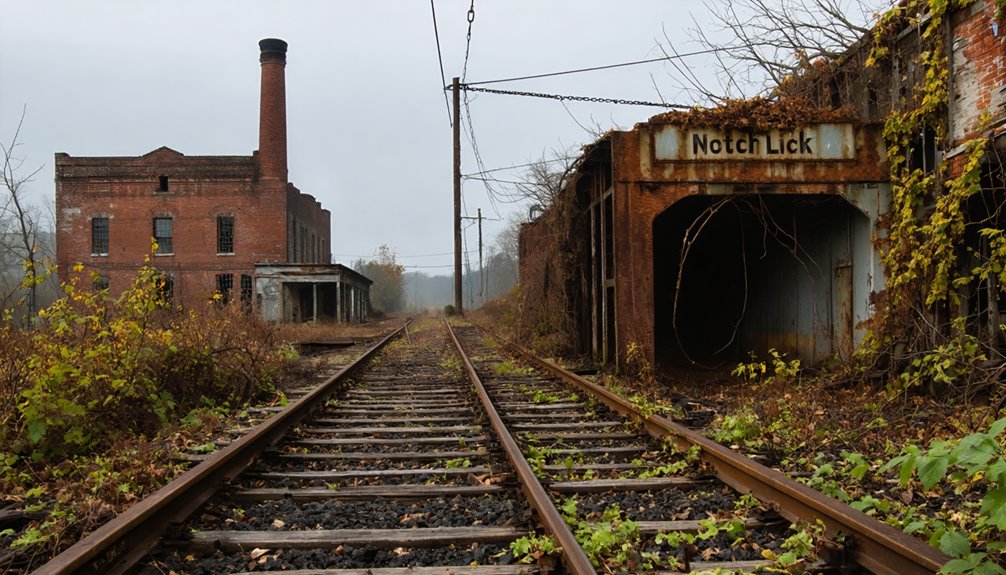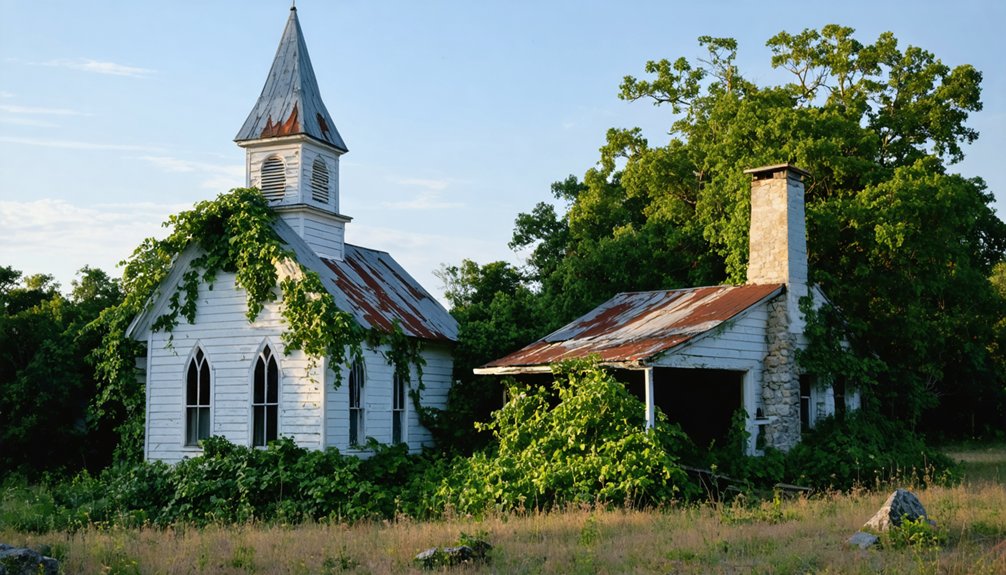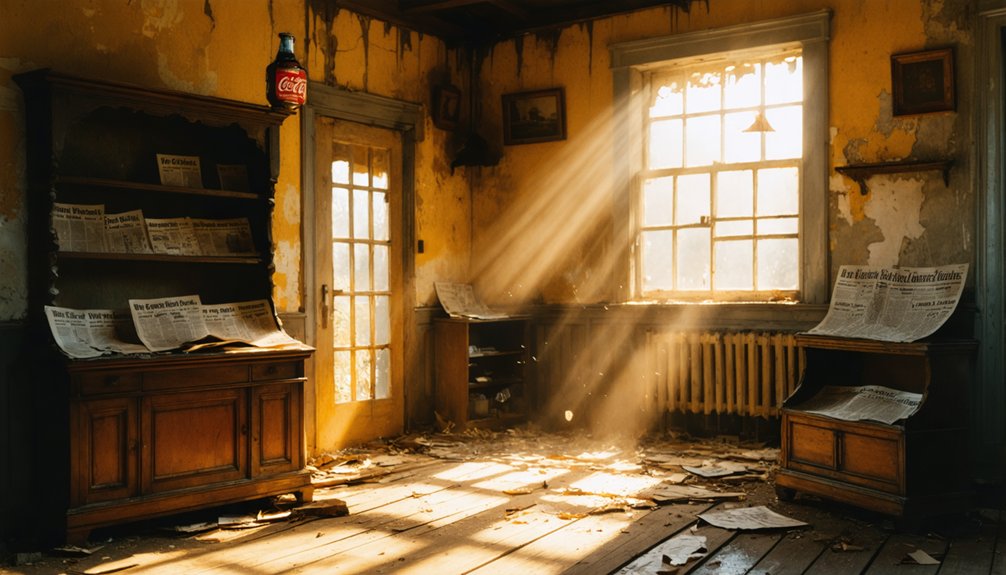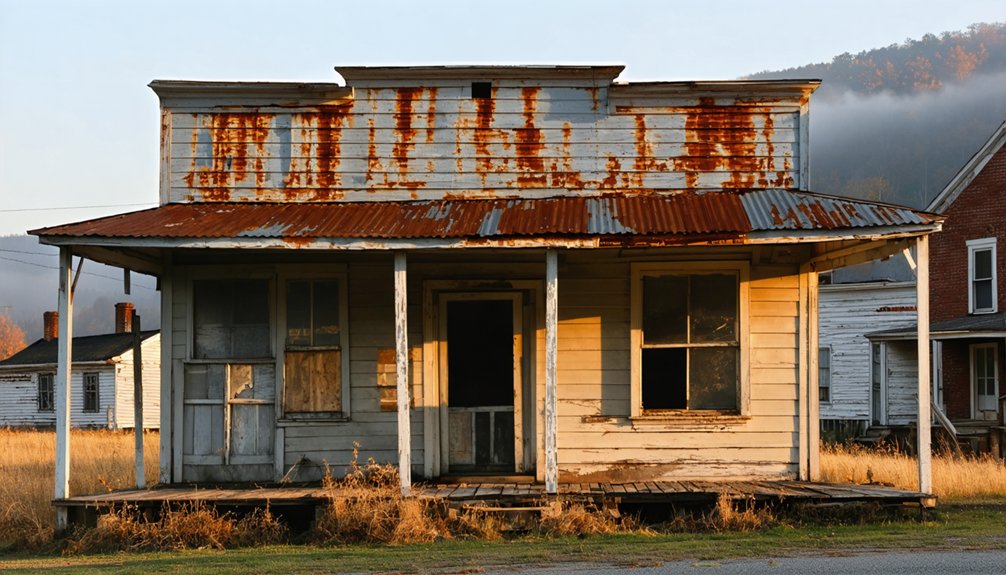You’ll find Notch Lick at N38.70145° W85.22857° in Kentucky, where sulfur mining once drew 100 residents in the 1880s. The town got its name from a gap between hills (“notch”) and a natural salt deposit (“lick”). Today, crumbling foundations peek through overgrown grass, while abandoned houses and an old convenience store slowly surrender to nature. Local legends whisper of supernatural guardians protecting this mysterious ghost town‘s remains, one of Kentucky’s 13 documented abandoned communities.
Key Takeaways
- Notch Lick was a small Kentucky settlement that thrived briefly in the 1840s due to sulfur extraction before declining into a ghost town.
- Located at coordinates 38.69296°N, -85.23985°W, the town’s remains are now largely obscured by dense vegetation and natural erosion.
- The community peaked with approximately 100 residents in the 1880s but declined rapidly after local sulfur deposits were depleted.
- Abandoned houses, historic churches, and building foundations are still visible among overgrown grass and wooded surroundings.
- The ghost town is among Kentucky’s 13 documented abandoned communities, known primarily to local historians rather than paranormal enthusiasts.
The Origins of Notch Lick’s Unusual Name

While you might chuckle at the name “Notch Lick,” this Kentucky ghost town‘s unusual moniker stems from two common geographical terms in the region. The place name origins reflect a landscape where a “notch” marked a gap between hills, while a “lick” indicated either a natural salt deposit or small stream that attracted wildlife.
Interestingly, the town was first called “Knob Lick,” referring to a rounded hill near a mineral deposit. Its cultural significance shifted when it briefly became “Antioch” in the mid-1800s, named after a local church. Today, the area features a few churches and one gas station among several abandoned houses. The lack of reliable documentation makes it challenging to verify many historical details about the settlement.
When the post office later reopened, the name reverted to “Knob Lick,” with “Notch Lick” emerging as a variant. It’s a name that perfectly captures the relationship between early Kentucky settlers and their natural surroundings.
Mapping the Lost Settlement
If you’re trying to locate the exact boundaries of Notch Lick today, you’ll encounter significant mapping challenges due to vanished landmarks and conflicting early survey records from Carroll County.
While modern GPS coordinates place the site at N38.70145° W85.22857°, the historic settlement’s full footprint remains uncertain as many original reference points, including old trees and fence lines, no longer exist.
Early surveyors’ notes from the area disagree on several key boundary markers, leaving historians to piece together the settlement’s precise layout through fragmented map overlays and stream course documentation.
Similar to the Cedar Bluff community that dwindled to just 20 residents by 1990, Notch Lick’s population steadily declined until the settlement disappeared entirely.
The nearby Little Kentucky River, located just 1.8 miles from the site, serves as one of the few reliable geographic reference points for mapping the historic settlement’s location.
Geographic Position Challenges
Despite having precise coordinates of 38.69296°N, -85.23985°W, mapping Notch Lick presents significant challenges for modern cartographers and historians.
Modern technology has implemented real-time validation systems to verify geographic data accuracy with satellite imaging.
You’ll find this ghost town‘s historical significance obscured by nature’s reclamation – dense vegetation and erosion have erased many physical traces of the once-vibrant community dynamics.
When you explore the site at its recorded elevation of 489 feet, you’re confronted with the harsh reality that time has stripped away the markers that would make field verification possible.
Similar to place name disambiguation challenges with other locations, historical records often confuse this site with similarly named settlements.
Without standing structures or clear boundaries, you’re left piecing together fragments from old USGS maps and county records.
Modern GPS technology can’t compensate for the absence of visible landmarks, making it tough to definitively pinpoint where this lost Kentucky settlement once thrived.
Early Survey Records Debate
The historical surveying methods used to map Notch Lick reveal a complex web of challenges that modern researchers still grapple with today.
You’ll find that early surveyors, working with the Public Land Survey System, often focused on township boundaries while giving less attention to smaller settlement patterns within. When you examine the original records, you’ll notice they’re riddled with discrepancies – damaged markers, misaligned reference points, and imprecise documentation of ephemeral communities.
Survey accuracy becomes even more questionable in Floyd County’s rugged terrain, where the rectangular PLSS system struggled to capture the true landscape.
You can’t rely solely on these early maps, as archaeological surveys have found no recorded sites in some areas where settlements were thought to exist, forcing researchers to cast a wider net in their search for Notch Lick’s exact location.
Landmarks Now Vanished
Situated at precise coordinates 38.69296°N and 85.23985°W, Notch Lick‘s physical remnants have completely vanished from Kentucky’s Carroll County landscape.
You won’t find a single original structure marking this ghost town‘s historical significance – no weathered church steeples, rusty gas pumps, or crumbling foundations remain to tell its tale.
The settlement’s location, while precisely mapped within ZIP code 41008, now blends seamlessly into the surrounding countryside. Like Paradise’s coal town, Notch Lick’s buildings and infrastructure have been entirely erased from view.
If you’re exploring the area, you’ll find Locust about 1.4 miles to the WNW and Kings Ridge 1.4 miles to the SSE, but Notch Lick’s former community dynamics have faded into memory.
Unlike Kentucky’s preserved ghost town of Blue Heron, no restoration efforts exist to showcase what once stood here.
Major transportation changes in the region likely contributed to the town’s eventual abandonment and decline.
Life in Early Notch Lick
Along the winding creeks of frontier Kentucky, early settlers in Notch Lick carved out a rugged existence during the late 18th and early 19th centuries.
You’d find these hardy folks building log cabins near water sources, clearing land for subsistence farms, and forging tight-knit community dynamics through shared labor and mutual aid. Maize cultivation became the foundation of their farming efforts, having spread from Mexico centuries earlier.
Life’s daily challenges meant rising with the sun to tend crops, hunt wild game, and gather nature’s bounty from the surrounding wilderness. Like many early settlements in Madison County, Notch Lick’s location was determined by its proximity to creeks and crossroads.
You couldn’t rely on formal stores or doctors – instead, you’d trade with neighbors, learn local plant remedies, and join forces for barn raisings and harvest seasons.
Your community gathered in simple homes or around crackling fires, where news traveled by word of mouth and decisions were made by consensus among household heads.
Every day tested your self-reliance and frontier spirit.
The Rise and Fall of Local Industries

In Notch Lick, you’ll find remnants of coal operations that began in the late 1800s, when local entrepreneurs first discovered rich seams beneath the rolling Kentucky hills.
The mines provided steady employment for nearly a century, transforming this quiet farming community into a bustling hub of coal production and related commerce.
Mining Operations Timeline
While coal had been used to warm Kentucky settlers’ campfires since Thomas Walker’s 1750 discovery, commercial mining didn’t take root until 1820 when the first operation opened in Muhlenberg County’s Western Coalfield.
You’ll find rich cultural heritage in the region’s growth, as production skyrocketed from 328 tons that first year to 100,000 tons by 1843. The historical significance of Kentucky’s coal industry became clear when output hit one million tons by 1879, just as the Eastern Coalfield began operations in Bell County.
The industry’s evolution mirrors America’s own industrial transformation – from simple hand-loading methods to mechanized systems. By 1917, landmarks like Lynch’s Portal 31 mine showcased cutting-edge technology, though this modernization eventually led to fewer mining jobs and the decline of coal camps.
Economic Impact Assessment
Despite its modest beginnings, Notch Lick’s economic story stands as a classic boom-and-bust tale centered around sulfur extraction.
You’ll find that the town’s fortunes rose quickly in the 1840s when drillers accidentally struck sulfur while searching for salt water. This discovery sparked the construction of a hotel and attracted enough workers to build a small but bustling village of around 100 residents by the 1880s.
The town’s economic isolation, however, proved to be its undoing. Without access to major waterways or railways, Notch Lick couldn’t expand beyond its limited sulfur operations.
Once the easily accessible deposits ran dry, the town’s economic foundation crumbled. The workers left, the hotel closed, and the village gradually faded into the quiet ghost town you’ll see today.
Remnants and Ruins Today
Today’s visitors to Notch Lick encounter a haunting tableau of rural decay, where multiple abandoned houses stand in various states of deterioration among the Kentucky countryside.
The local architecture tells a story of what once was – from weathered church steeples to an old gas station’s rusted signage. Nature’s slow reclamation of the town creates a striking environmental impact, with vegetation weaving through forgotten foundations and around crumbling walls.
- You’ll find at least two historic churches still standing, their silent bell towers marking what remains of this former community.
- An abandoned convenience store hints at bustling days long past.
- Small foundations peek through overgrown grass, marking where homes once stood.
- The wooded surroundings create a peaceful, if somewhat eerie, atmosphere perfect for urban exploration.
Notable Historical Buildings and Structures

If you’d wander through Notch Lick’s remnants today, you’ll find the weathered shell of the mining company’s office standing as a tribute to the town’s coal-driven past.
The crumbling stone railroad bridge, once essential for transporting coal shipments, still spans the creek bed where trains regularly thundered through.
The local general store’s foundation and partial walls remain visible among the overgrowth, marking where miners and their families once gathered for supplies and community connection.
Abandoned Mining Company Office
Among the skeletal remains of Notch Lick’s industrial past, the abandoned mining company office stands as a monument to the town’s coal-mining heritage.
Built from local stone and brick, this once-bustling hub managed the lifeblood of the community’s coal operations. You’ll find traces of its former glory in the barred windows and sealed vaults where payroll was once stored.
- The building’s multi-room layout reveals spaces where mine bosses coordinated daily operations
- Original features include heavy-duty storage bins, now rusted and locked tight
- Weathered walls still show faded outlines where company emblems once proclaimed ownership
- Like many abandoned structures throughout Kentucky’s coal country, it symbolizes the shift from industrial powerhouse to ghost town, sharing architectural DNA with nearby Lynch’s preserved mining offices
Stone Railroad Bridge Ruins
Just beyond the mining office, the stone railroad bridge ruins stand as silent sentinels of Notch Lick’s transportation legacy.
These massive stone piers, stretching up to 90 feet high, once supported a steel camelback truss that carried freight and passengers through Kentucky’s rugged terrain. You’ll notice the expert stonework in the weathered abutments – a proof of late 19th-century bridge architecture that’s endured decades of abandonment.
Built during the region’s railroad history boom, this bridge connected Notch Lick to essential commercial routes until the mid-1900s.
While the steel superstructure’s long gone, the remaining stone foundations tell stories of coal shipments, passenger trains, and the town’s bustling past.
Today, these ruins serve as a haunting reminder of how quickly fortunes can change when transportation routes shift.
Local General Store Remains
Standing proudly at the heart of Notch Lick’s commercial district, the two-story brick general store remains a tribute to early 20th-century commerce. Under A.O. Calico’s ownership, it served as more than just a shop – it was the cornerstone of pre-1900 commerce and rural community dynamics.
You’ll find evidence of thoughtful construction in its metal cornices and window lintels, showcasing the era’s finest vernacular commercial architecture.
Here’s what makes this historical landmark truly special:
- Resilient brick construction that’s withstood over a century of Kentucky weather
- Original three-bay design perfect for displaying goods to passing travelers
- Dual-purpose layout with retail space below and storage above
- Metal architectural details that speak to the craftsmanship of the period
The store continues its commercial legacy today, adapting to serve modern needs while preserving its historical character.
Stories From Former Residents

While memories of Notch Lick’s bustling coal-mining days still echo through former residents’ stories, their accounts paint a portrait of both resilience and heartbreak during the town’s decline.
You’ll hear tales of community resilience in their descriptions of neighbors helping neighbors through hard times, gathering at local churches, and maintaining hope even as the mining jobs disappeared.
Economic nostalgia permeates their recollections of company-owned homes and tight-knit social bonds that defined daily life.
In their memories, the rhythm of shared living echoes through company houses, where neighborly bonds wove the fabric of everyday existence.
When technological advances reduced mining jobs, families faced painful choices to leave their hometown behind.
Those who stayed watched as schools closed, stores shuttered, and homes fell into disrepair.
Yet many former residents still maintain connections to Notch Lick, visiting family gravesites and holding onto memories of their once-thriving community.
Local Legends and Folklore
Deep in Kentucky’s folklore, Notch Lick’s mysterious disappearance has spawned countless tales of supernatural forces and divine retribution.
You’ll hear whispers of supernatural guardians protecting the town’s remains, warning curious explorers to stay away. Unlike Kentucky’s famous Pope Lick Monster or Louisville’s Witches’ Tree, Notch Lick’s legend focuses on an entire community’s vanishing act, swallowed by the earth without a trace.
- Local curses are said to plague those who dare search for the town’s remains.
- Strange occurrences follow anyone who ventures too close to the lost settlement.
- The town’s disappearance remains unexplained, with no physical evidence left behind.
- Each retelling adds new layers to the mystery, keeping the legend alive through generations.
The story’s power lies in what you can’t see – a haunting reminder of Appalachia’s mysterious landscape.
Preservation Efforts and Current Status

Today, Notch Lick stands as a haunting memorial to Kentucky’s vanishing rural communities, with only scattered architectural remnants hinting at its former energy.
You’ll find preservation challenges at every turn, from crumbling structures reclaimed by nature to the ongoing battle against time and weather. Local historical societies have stepped up to document what remains, though they’re working with limited resources and competing priorities.
If you’re planning to explore this piece of Kentucky’s past, you’ll discover a ghost town that’s caught between preservation and decay.
Community involvement remains essential for its survival, with dedicated locals working to save what they can. While tourism potential exists, the town’s future hangs in the balance as preservation efforts compete with natural reclamation and infrastructure decline.
Legacy Among Kentucky’s Ghost Towns
Among Kentucky’s ghost towns, Notch Lick stands as one of the state’s more enigmatic abandoned communities, lacking the dramatic narratives that define places like Paradise or Blue Heron.
You won’t find the usual ghost town preservation efforts or tourist attractions here – instead, Notch Lick represents a quieter chapter in Kentucky’s rural history.
- Unlike Paradise’s famous TVA buyout or Blue Heron’s mining legacy, Notch Lick’s historical significance remains understated.
- You’ll find it listed among Kentucky’s 13 documented ghost towns, though it’s far less known than its western counterparts.
- The town’s story mirrors countless rural communities that faded without fanfare or focused preservation attempts.
- While other Kentucky ghost towns attract paranormal enthusiasts and history buffs, Notch Lick maintains its mystery, known primarily to dedicated local historians.
Frequently Asked Questions
Are There Any Dangerous Wildlife Encounters Reported in Notch Lick’s Abandoned Areas?
Like a whisper in the wilderness, your chances of dangerous wildlife encounters are low. You’ll likely spot harmless owls and deer, but taking basic safety precautions protects you from snakes and ticks.
What Natural Disasters or Weather Events Contributed to Notch Lick’s Decline?
While storm impact and flood damage affected many Appalachian coal towns, you won’t find specific natural disasters driving Notch Lick’s decline – it succumbed gradually to economic pressures, not weather events.
Did Any Famous People or Historical Figures Ever Visit Notch Lick?
Picture a town lost to time’s mists – you won’t find records of famous visitors or historical landmarks in Notch Lick’s story. The small mining town’s notable guests remain unknown, if any came at all.
Were There Any Native American Settlements in the Notch Lick Area?
You won’t find concrete historical evidence of Native American settlements at Notch Lick, though they likely passed through while hunting and gathering, similar to their documented activities at nearby Big Bone Lick.
What Transportation Routes or Railways Once Connected Notch Lick to Other Towns?
You’d find historic transportation centered on the L&N Railroad, which connected Notch Lick to Richmond and Berea, while the Kentucky Central Railway offered links to Paint Lick and Silver Creek.
References
- https://wkdq.com/kentucky-lake-town-has-a-truly-terrifying-past-and-people-are-warned-never-to-go-there/
- https://kids.kiddle.co/List_of_ghost_towns_in_Kentucky
- https://www.youtube.com/watch?v=D9gOmfCuKLs
- https://www.youtube.com/watch?v=CdlhDpJbpvQ
- https://www.abandonedspaces.com/towns/lynch-kentucky.html
- https://wbkr.com/visit-these-20-creepy-kentucky-ghost-towns-for-a-halloween-road-trip/
- https://en.wikipedia.org/wiki/List_of_ghost_towns_in_Kentucky
- https://www.youtube.com/shorts/U7-djL5yp2c
- https://www.wikiwand.com/en/articles/List_of_ghost_towns_in_Kentucky
- https://www.onlyinyourstate.com/experiences/kentucky/12-ghost-towns-in-ky



